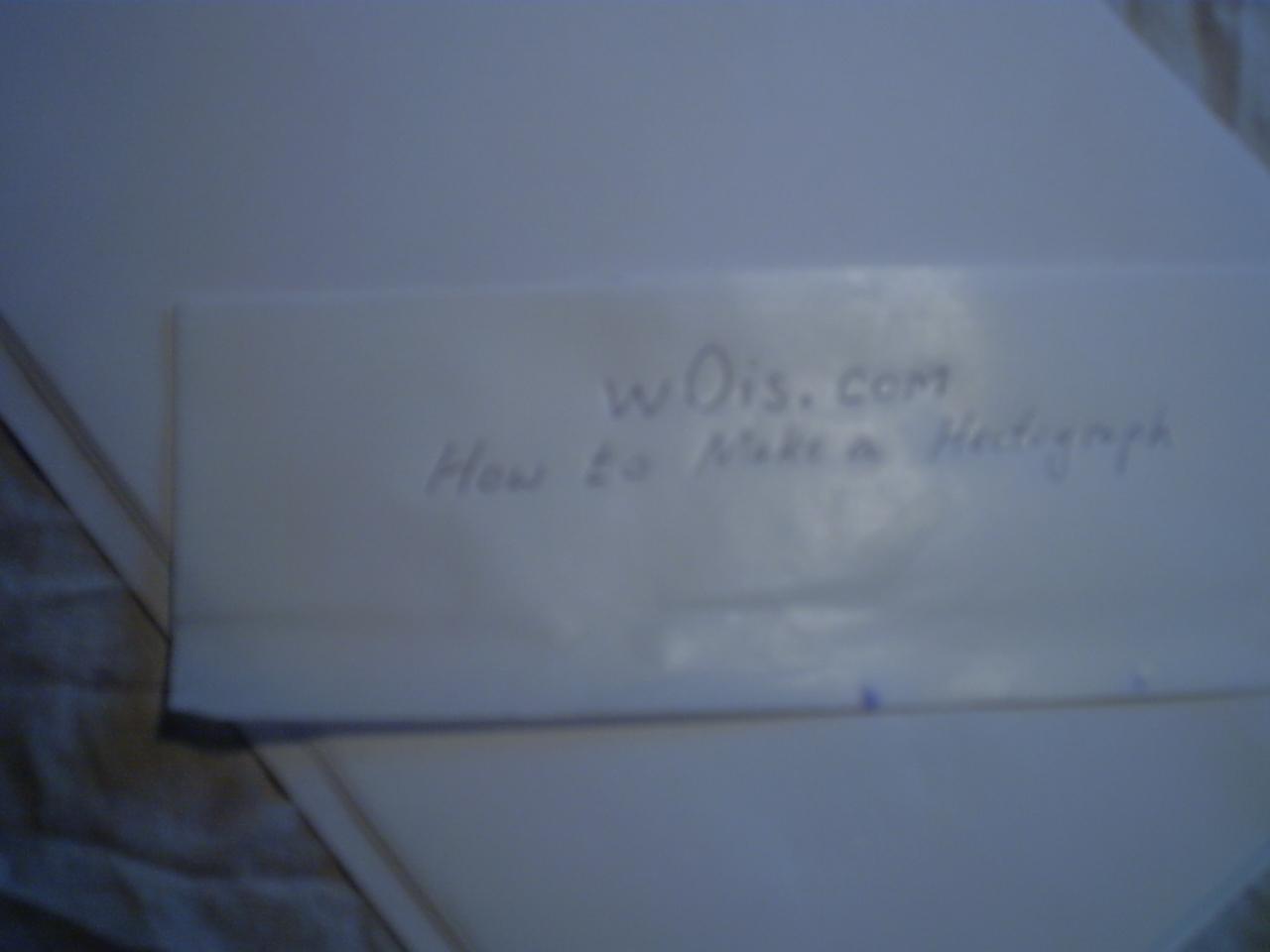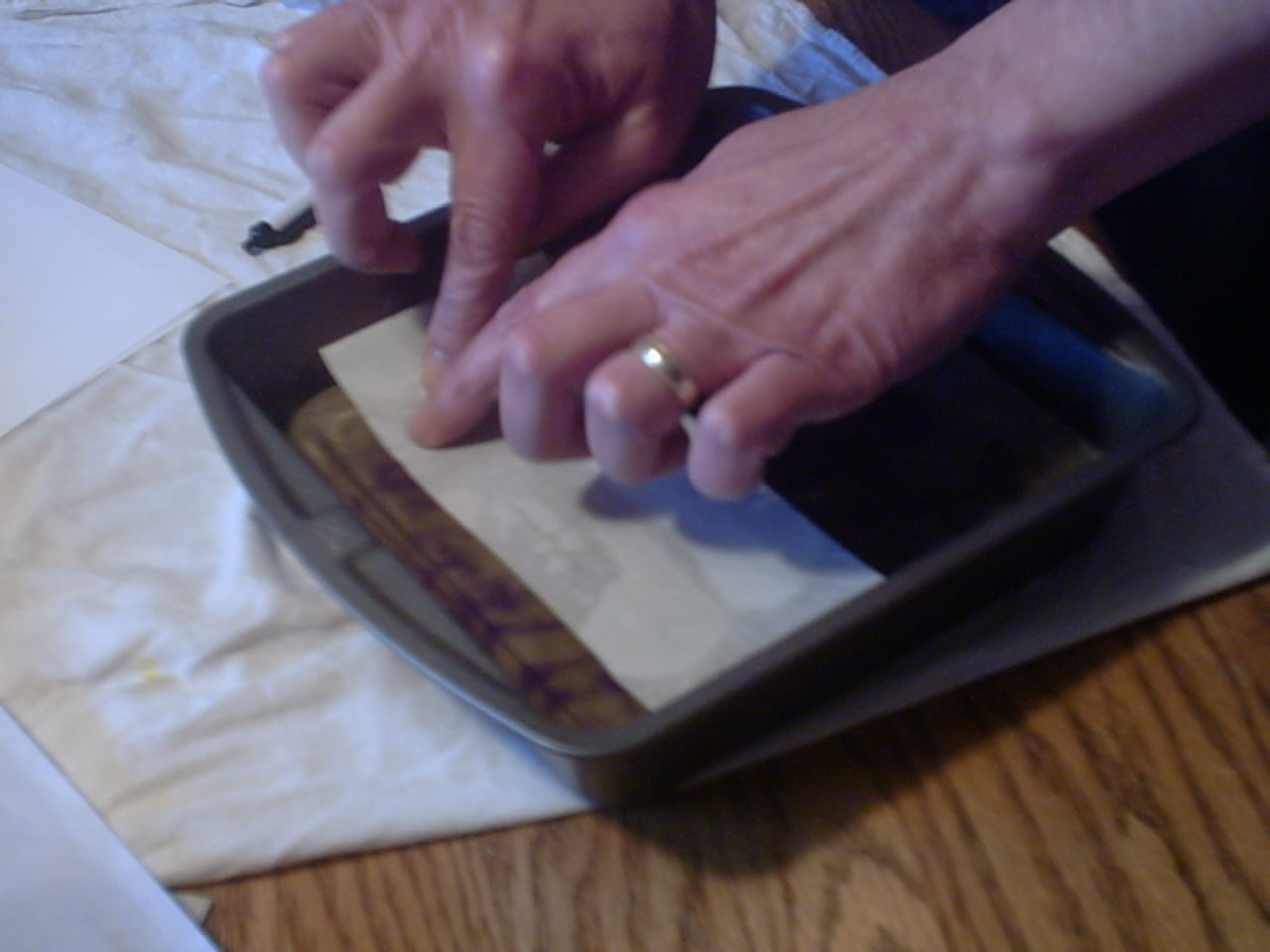

The hectograph was an early duplicating method. "Hecto" means one hundred, so this is a method designed to make (roughly) a hundred copies of something. With the advent of cheap computer printers, there's not a lot of practical use for this technology. But it's a fun method of duplicating, and produces surprisingly good copies. With this type of gelatin duplicator, you start with the image on a piece of paper, you transfer the image to the gelatin, and then you transfer the image to blank sheets of paper.
The hectograph essentially consists of a pan of gelatin. I've never tried it with nothing but gelatine, although prisoners of war during World War 2 are reported to have made a duplicator from the gelatin desert from their meals. Most of the recipes that I have found include other ingredients, such as glycerine or boric acid.
In addition to the ingredients below, you will need some sort of metal pan (such as a baking pan) sufficiently large for the sheets of paper you want to copy. To maximize the surface area of the gelatine, you'll want a pan with as flat a surface as possible.
I didn't try it, but the recipe on the following page calls for boric acid:
http://www.kidskreate.com/article_1064.html
The unflavored gelatine is readily available in supermarkets. The boric acid might be available at a well-stocked pharmacy. I inquired at a local Walgreen's, and they told me that they could order it as a special order and have it in a few days. Boric acid is a relatively harmless chemical. It was used for many years as an eye wash, so presumably you needn't worry about getting it on your eyes or skin. I wouldn't ingest it, but it's not particularly poisonous or dangerous. If you can't find it locally, you can also order it online at Amazon from any of the links below:
The recipe I used originated from the following page:
http://www.fell.demon.co.uk/steve/jelly.html
This recipe, which worked well for me, uses glycerine mixed with the gelatine. Glycerine (not to be confused with nitroglycerine) is also very safe. It's normally used as a hand moisturizer. My local Walgreen's had a few bottles in stock. I bought a four-ounce bottle, which I used for the recipe below. If you can't find it locally, the glycerine is also available at Amazon, from any of the links below:
For the gelatine, I used Knox unflavored gelatine. It will be readily available in any grocery store, but it is also available from Amazon:
I used one box, containing four individual envelopes. You will also need about a half cup of sugar. Surely you have sugar around the house, but if you need to order it online, it, too, is available at amazon:
Preparing the gelatine is quite simple, however patience is required. Warning: The hectograph is a safe and fun activity for kids. However, preparing the solution should be left to adults. You need to boil the gelatine-glycerine mixture, and this has a much higher boiling point than water. You're essentially working with boiling oil, so it's not a safe activity for kids.
As you can see, my recipe differs slightly from the original recipe. So the quantities are not critical. I used four packets of gelatine, four ounces of glycerine, and a half cup of sugar.
In a large saucepan, dissolve four packets of gelatine in one half cup of water. Gently warm it while adding one half cup of sugar. After the gelatine and and sugar have dissolved, and 4 ounces of glycerine and slowly bring to a boil. You will need to stir constantly, and also keep a close watch on the heat so that the mixture comes to a gentle boil. The reason for stirring and keeping the heat to a bare minimum is to prevent, as much as possible, the formation of foam. There will be some foam which you can deal with in the next step, but keep it to a minimum.
After about one minute of boiling, remove from heat. Slowly pour the mixture into your pan. (Warning: remember, you're dealing with boiling oil at this point, so please be careful.) You will leave the mixture to cool, and when you are finished, this will be your completed hectograph. Make sure the pan is sitting on a level surface.
If you were careful during the boiling process, there will be only minimal foam and bubbles on the surface. But you will need to remove any remaining foam, so that the surface is perfectly smooth before it cools. The best way I found to do this was to use a small piece of paper and simply "rake" the bubbles off to one side and then remove them with a spoon. If there are a few bubbles left near the edge, this will not be a problem. But the surface you will use to print must be perfectly smooth.

As the mixture cools, it will harden into the consistency of thick Jello. Allow it to completely cool and harden. A few hours should be sufficient, but I left it overnight.
When you are not using the hectograph, you should cover the surface. I simply used a sheet of printer paper. Glossy paper is probably the best.
The hectograph co-existed for many years with its bigger sibling, the mimeograph machine, also known as the "ditto machine". If you're old enough, you remember getting worksheets in school printed in purple ink. These were printed on a mimeograph machine, which uses a process similar to the hectograph. The good news for aspiring young printers was that the material needed to make your master copy, the "ditto master" was readily available at any store that sold office supplies. Since the "ditto" machine is also ancient technology, these are no longer readily available. But they can still be found.
Please support this page by supporting our advertisers by using the following links:

Apparently, "ditto masters" (also known as "mimeograph masters" or "spirit masters") are still used by the tattoo industry. They are used to make temporary tattoos, and templates for permanent tattoos. Therefore, if you ask nicely, a local tattoo parlour might be willing to sell or give you one for use with your hectograph.
If you can't find them locally, you can get them on Amazon at a very reasonable price, currently about $1.75 for fifteen sheets:
I believe that these are "new old stock" manufactured during the heyday of the "ditto machine".
I haven't tried them, but there are also "hectograph pencils" available, also known as "tattoo stencil pencils":
For those of you who are old enough to remember the mimeograph, you probably remember that you prepared the master so that everything was backwards. You wrote or drew on one side of the master, with the carbon paper facing the back of the page, and a mirror image appeared on the back. For the hectograph, you will not use the same procedure. You place the carbon paper between two sheets of paper, write on the back sheet, and you will get a copy on the other sheet, not a mirror image. If you are using the "ditto masters" from the link above, you will write on the yellow sheet, and the white sheet will become the master.
If you are using hectograph pencils, you just write with them on a normal sheet of paper, and this will become your master.
I did do some experimentation with different felt-tipped markers we had around the house, and some of them did form an adequate master. It seems to have depended on the color more than the brand. Some worked quite well, and some didn't work at all. So if you can't find the ditto masters or hectograph pencils, you might still be able to experiment and find a marker that works.
this Youtube video shows a master being made using
Vis-A-Vis Markers
(the type used with another archaic technology, the overhead projector). They appear to give very good results.
Your completed master will look something like this:

Once you have prepared your master, you will have a sheet that looks like what your finished product will look like. If you were lucky enough to find markers that worked, you can make a multi-colored original. If you use the "ditto masters", you will have purple. The site above has a link for making your own hectograph ink, which I have not tried.
When your master is ready, you are ready to start making copies. Remove the protective sheet you placed on your hectograph. With a sponge and cool water, gently dampen the surface of the hectograph. Then, place your master face down on top of the gelatine surface and wait about a minute. (Fold up one corner of the master so that you can easily remove it from the surface. Or, you can leave a narrow strip of paper at one end of the pan so that you'll have a spot to grip the sheet to remove it.) Sometimes, it helps the transfer process to gently wipe the back of the master with a damp sponge. Then, gently peel off the master, and you are ready to copy.
Applying the master:

To make your first copy, simply place another sheet of paper on the surface of the hectograph. Wait a few seconds, and then peel it off. When you do, you should be rewarded with a good copy of your original. Repeat for as many copies as you need. As you progress, each copy will get slightly dimmer, but they will continue to be legible. Generally, you should be able to get 25-30 good copies. I've never been able to make the hundred copies promised by the "hecto" name.
A sample is shown at the top of this page. I made this hectograph a few months ago, and it has dried out somewhat over the intervening months. When new, the copies were a bit darker. It is possible to refresh the gelatine by removing it, melting it, and pouring it into the pan again. In fact, I was able to remove the gelatine from the pan as a single piece, so it would be possible to continue using it without the pan.
When you are finished, you can simply rinse off the surface by gently wiping it with a sponge, and cover it up with a clean sheet of glossy paper. After several hours, your original image actually sinks down into the gelatine, and the hectograph is ready to make another original.
Here are some additional links you might find interesting or useful:
If you're interested in making a hectograph, you're probably the kind of person who is also interested in sending secret messages with a one-time pad.
Please support this page and our advertisers by using the following links:

©2011-13 W0IS.com
Return to my main page
Copyright and privacy policy